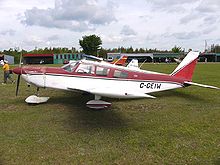- Piper PA-32
-
PA-32 Cherokee Six/Saratoga 1973 model Piper PA-32-300 Cherokee Six Role personal use and air taxi aircraft Manufacturer Piper Aircraft First flight 6 December 1963 Introduction 1965 Status Production completed 2007 Number built 7842+ The Piper PA-32 Cherokee Six is a series of six or seven seat, fixed landing gear, light aircraft, that was manufactured in the United States by Piper Aircraft between 1965 and 2007.[1][2]
Contents
Development
The PA-32 series began life in 1965 as the 260 horsepower (190 kW) PA32-260 Cherokee Six, a significantly modified six (or seven) seat development of the PA-28 Cherokee.[1][2]
The Cherokee Six and its successors feature a baggage compartment in the nose between the cockpit and the engine compartment as well as a large double door in the back for easy loading of passengers and cargo.[1][2]
PA-32-300
Many pilots thought the original 260 hp (190 kW) Cherokee Six was under-powered so on 27 May 1966 Piper obtained FAA type certification for a 300 hp (220 kW) version, designated as the PA-32-300. It was offered by the company as a 1967 model.[3]
PA-32R
Main article: Piper PA-32RThe 1975 addition of retractable landing gear resulted in the first of the PA-32R series, the Piper Lance. This was the earliest aircraft in the Piper Saratoga family, Piper's luxury high-performance single line.[1][2]
Piper's transition to tapered wings for the Cherokee series resulted in a new wing for the PA-32 series as well. The tapered-wing version of the Cherokee Six was named the Saratoga and debuted in 1980. Due to product liability concerns and economic conditions, the general aviation industry went into decline in the early 1980s and Saratoga production ceased in 1985.
Piper 6X
After the General Aviation Revitalization Act of 1994, production of the retractable-gear Saratoga resumed in 1995. A fixed-gear PA32 was re-introduced in 2003 as the Piper 6X and the turbocharged 6XT. Sales of the 6X and 6XT models did not meet expectations and production ceased in late 2007.
PA-34 prototype
Piper built a prototype PA32-260 with IO-360 engines mounted on the wings. The trimotor aircraft was the proof-of-concept aircraft for the twin-engined, retractable gear version of the Cherokee Six, the PA-34 Seneca.[4]
Variants
- PA-32-250 Cherokee Six
- Prototype with 250hp Lycoming O-540 engine, two built.
- PA-32-260 Cherokee Six
- Production variant with a 260hp Lycoming O-540-E4B5 engine.
- PA-32-260 Cherokee Six B
- 1969 model with increased cabin space
- PA-32-260 Cherokee Six C
- 1970 model with minor changes
- PA-32-260 Cherokee Six D
- 1971 model with minor changes
- PA-32-260 Cherokee Six E
- 1972 model with interior and instrument panel changes (note model letters not used after 1972)
- PA-32-300 Cherokee Six
- Variant with a 300hp Lycoming O-540-K engine, named the Piper Six 300 after 1979.
- PA-32-300 Cherokee Six B
- 1969 model with instrument panel changes
- PA-32-300 Cherokee Six C
- 1970 model
- PA-32-300 Cherokee Six D
- 1971 model
- PA-32-300 Cherokee Six E
- 1972 model (note model letters not used after 1972)
- PA-32-300LD
- Experimental low-drag variant for increased fuel efficiency, one built.
- PA-32S-300 Seaplane Version
- Factory built on floats, only a small number were made.
- PA-32-301 Saratoga
- Variant from 1980 with a 300hp Lycoming IO-540-K1G5 engine
- PA-32-301T Turbo Saratoga
- Saratoga with a turbo-charged Lycoming TIO-540-S1AD engine and revised cowling.
- PA-32-3M
- PA-32 prototype modified as a three-engined aircraft with two 115hp Lycoming O-235 engines fitted to the wings, for development of the PA-34 Seneca.
Specifications (1972 model PA-32-300)
Data from 1972 Piper Cherokee Six 300 "E" Owner's Handbook
General characteristics
- Crew: One
- Capacity: five passengers (or six with optional seat)
- Length: 27.7 ft in (8.4 m)
- Wingspan: 32.8 ft in (10.0 m)
- Height: 7.9 ft in (2.4 m)
- Wing area: 174.5 ft2 (16.5 m2)
- Wing profile: NACA 65-415
- Empty weight: 1788 lb (811 kg)
- Gross weight: 3400 lb (1542 kg)
- Powerplant: 1 × Lycoming IO-540-K1A5, 300 hp (225 kW)
Performance
- Maximum speed: 174 mph (280 km/h)
- Cruise speed: 168 mph (272 km/h)
- Range: 840 miles (1361 km)
- Service ceiling: 16250 ft (4950 m)
- Rate of climb: 1050 ft/min (5.3 m/s)
References
- ^ a b c d Plane and Pilot: 1978 Aircraft Directory, page 63. Werner & Werner Corp, Santa Monica CA, 1977. ISBN 0-918312-00-0
- ^ a b c d Montgomery, MR & Gerald Foster: A Field Guide to Airplanes, Second Edition, page 32. Houghton Mifflin Company, 1992. ISBN 0-395-62888-1
- ^ Federal Aviation Administration (June 2007). "TYPE CERTIFICATE DATA SHEET NO. A3SO". http://www.airweb.faa.gov/Regulatory_and_Guidance_Library/rgMakeModel.nsf/0/175d1136cb8a68b6862572f700681ff3/$FILE/A3SO.pdf. Retrieved 2009-09-12.
- ^ Montgomery, MR & Gerald Foster: A Field Guide to Airplanes, Second Edition, p.96. Houghton Mifflin Company, 1992. ISBN 0-395-62888-1
External links
Piper aircraft Civilian E-2 · F-2 · G-2 · H-2 · J-2 · J-3 · J-4 · J-5 · PA-6 · PA-7 · PA-8 · PA-11 · PA-12 · PA-14 · PA-15 · PA-16 · PA-17 · PA-18 · PA-19 · PA-20 · PA-22 · PA-23 · PA-24 · PA-25 · PA-26 · PA-28 · PA-29 · PA-30 · PA-31 · PA-31T · PA-32 · PA-32R · PA-33 · PA-34 · PA-35 · PA-36 · PA-38 · PA-39 · PA-40 · PA-41 · PA-42 · PA-44 · PA-46 · PA-47 · PA-60 · PiperSport · PT-1 · PWA-1 · PWA-6 · PWA-8
Military Lists relating to aviation General Aircraft (manufacturers) · Aircraft engines (manufacturers) · Airlines (defunct) · Airports · Civil authorities · Museums · Registration prefixes · Rotorcraft (manufacturers) · TimelineMilitary Accidents/incidents Records Categories:- Low wing aircraft
- Single-engine aircraft
- Propeller aircraft
- United States civil utility aircraft 1960–1969
- Piper aircraft
Wikimedia Foundation. 2010.


